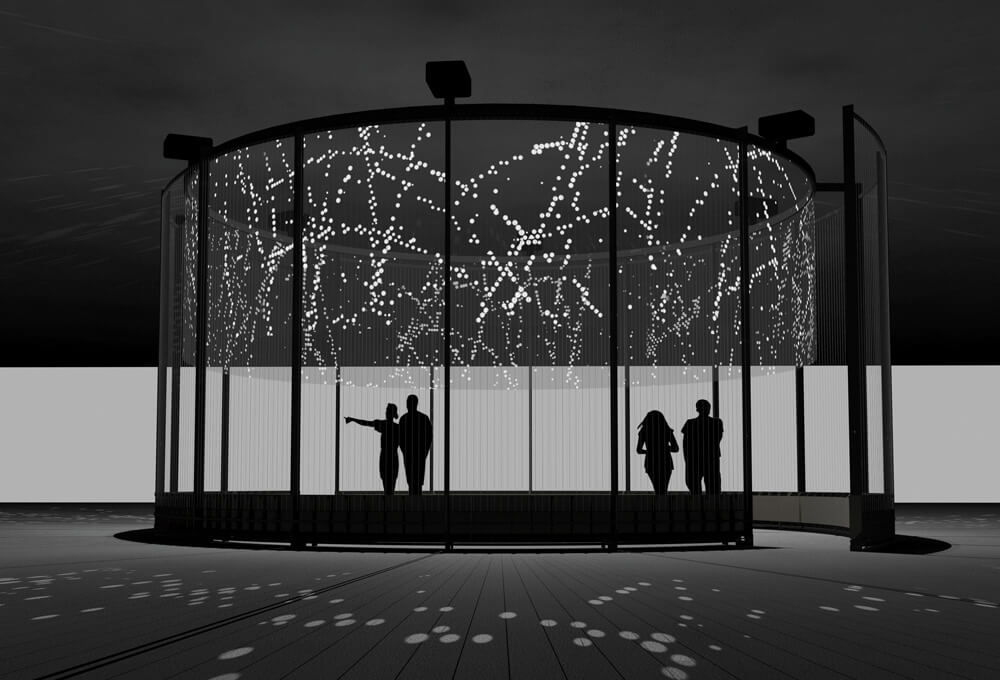Text by Meritxell Rosell

The materiality of nature is seen through a digitalised scientific and technological glass. That’s how UK-based Semiconductor approach their practice. Semiconductor are artist-duo Ruth Jarman and Joe Gerhardt and have been working together for over twenty years. They make moving image works and installations that explore the material nature of our physical world and how we experience it through science and technology.
Their starting point is always nature, looking at matter or events that exist beyond the limits of perception. They say that in the early days, they naturally turned to science as a way to reveal these things to us, but through this process, they started to notice that science came with a human signature and started to ask more philosophical questions of it.
Last year they presented an ambitious project at Sonar+D’s Sonar PLANTA, Earthworks. A large scale mesmerizing piece that represents the processes of the formation of the Earth and the constant changes that take place in its structure and landscape, from those caused by natural phenomena (earthquakes, erosion) to those caused by human activities that determine a new geologic era: the Anthropocene. For Art Basel 2018 and commissioned by Audemars Piguet Semiconductor will present HALO, an installation that aims to make the universe’s tiny particles visible and audible, told us Olivier Audemars, the vice-chairman of the board of directors at the company.
In recent years artists seem to be more and more blending the natural and the digital with their creations. For Semiconductor, the computer is been seen as the third member of the group. They were conducting it whilst it was doing them, with ways to organise nature, manage our processes, things that bring their digital aesthetics. They think that possibly, though, in the long run, the binary way of seeing nature will become less useful, and the digital will become as quaint as an oil painting.
For those that are not familiar with your work, could you tell us a little bit about your background? Who is behind Semiconductor?
We are artist-duo Ruth Jarman and Joe Gerhardt and have been working together for over twenty years. We make moving image works and installations that explore the material nature of our physical world and how we experience it through the lens of science and technology.
Our starting point is always nature, looking at matters or events that exist beyond the limits of our perception. In the early days, we naturally turned to science as a way to reveal these things to us, but through this process, we started to notice that science came with a human signature and started to ask more philosophical questions about it.
HALO is an installation that blends both art and science, using data collected at CERN, where Semiconductor took part in a two-month residency in 2015. Could you tell us more about the intellectual process behind the project?
When we were at CERN, we spent some of our time seeing if we could access some of the data that is being produced by the instruments on the Large Hadron Collider. We’re interested in scientific data and how it represents the matter it is studying. It could be photographs, strings of numbers, images and in this instance, space points in 3-D space.
We like to go back to the raw data, so the closest to it being captured or created by the instrument, this is before it has been processed by scientists, and it still bears the signature of the capturing technology. With the data from ATLAS, it is laid out in a circular form, the shape of the experiment; the presence of this framework is important to us as it gives a sense of how it has been captured, a context if you like. We want to look at the data in its own right, as a material form, not trying to glean scientific information from it but treating it as a distinct language.
What are the most significant challenges you faced during the development of HALO?
HALO has been a very ambitious project, pushing our ideas and the use of technology in new ways. There are a lot of custom-made circuit boards which drive the sound; these involved a lot of trial and error, working around power issues, and getting everything working just right. There have been a lot of people involved in making HALO, and through developmental periods you have to put a lot of trust that things are going to come together.
HALO takes the form of a large-scale installation exploring how science and technology frame our experiences of the natural world. What is your relationship with the natural world that is more and more being fused with the digital?
The idea behind the name Semiconductor was formed around the computer being the third member of our group. We were conducting it whilst it was conducting us, with ways to organise nature, manage our processes, things that bring their own digital aesthetics. Possibly though, in the long run, the binary way of seeing nature will become less useful, and the digital will become as quaint as oil painting.
Visitors will be invited to sit and lie down, surrounded by millions of data points collected by the Large Hadron Collider, a particle accelerator consisting of a 27-kilometre ring of superconducting magnets. What do you expect from the viewer that interacts with HALO?
HALO is ultimately an experience. You don’t need to know what it is that it has come from science. Looking at and listening to the data, there is a complexity that can only be made by nature, yet there is the suggestion of a technological framework and a rhythmic pattern that suggests a human hand. This combination suggests something that is bigger than us and overwhelming; when we work in this way, they become humbling experiences, and the data becomes a phenomenon to experience, what we call a technological sublime.






